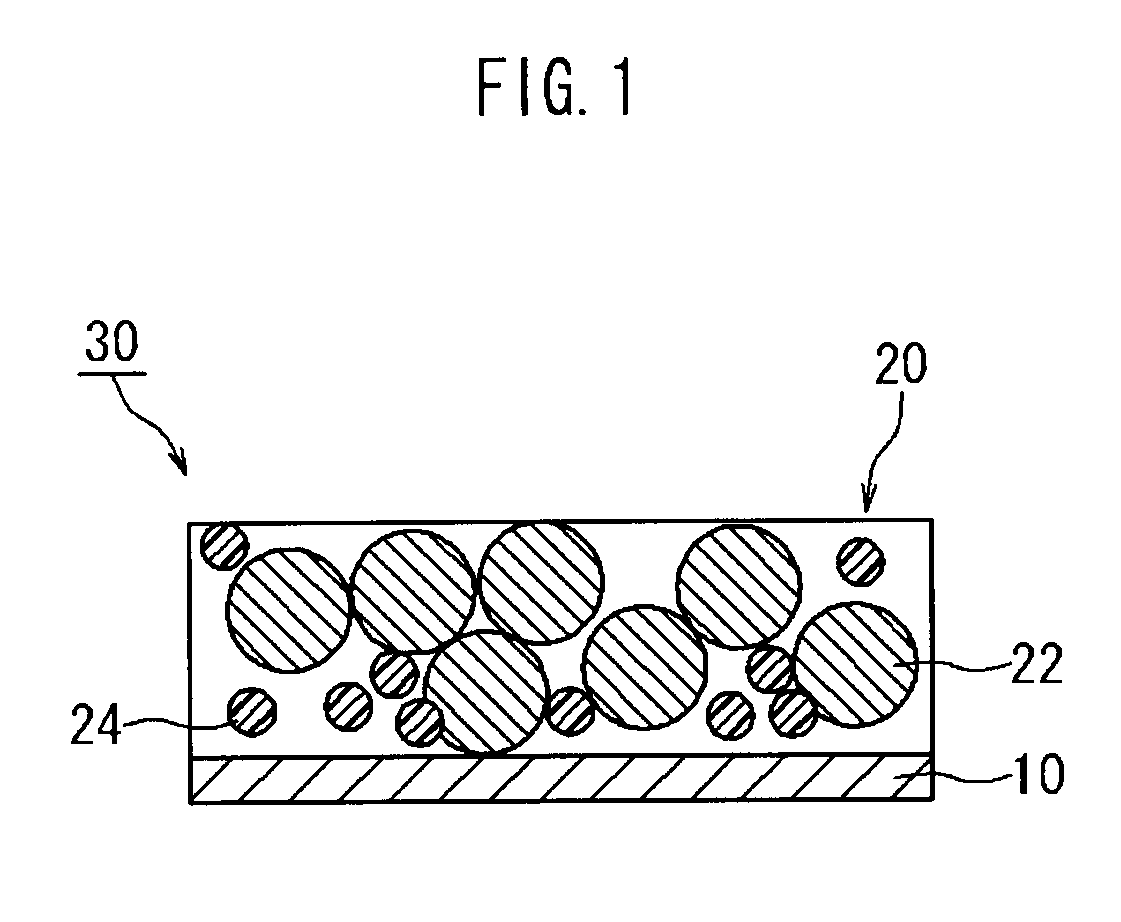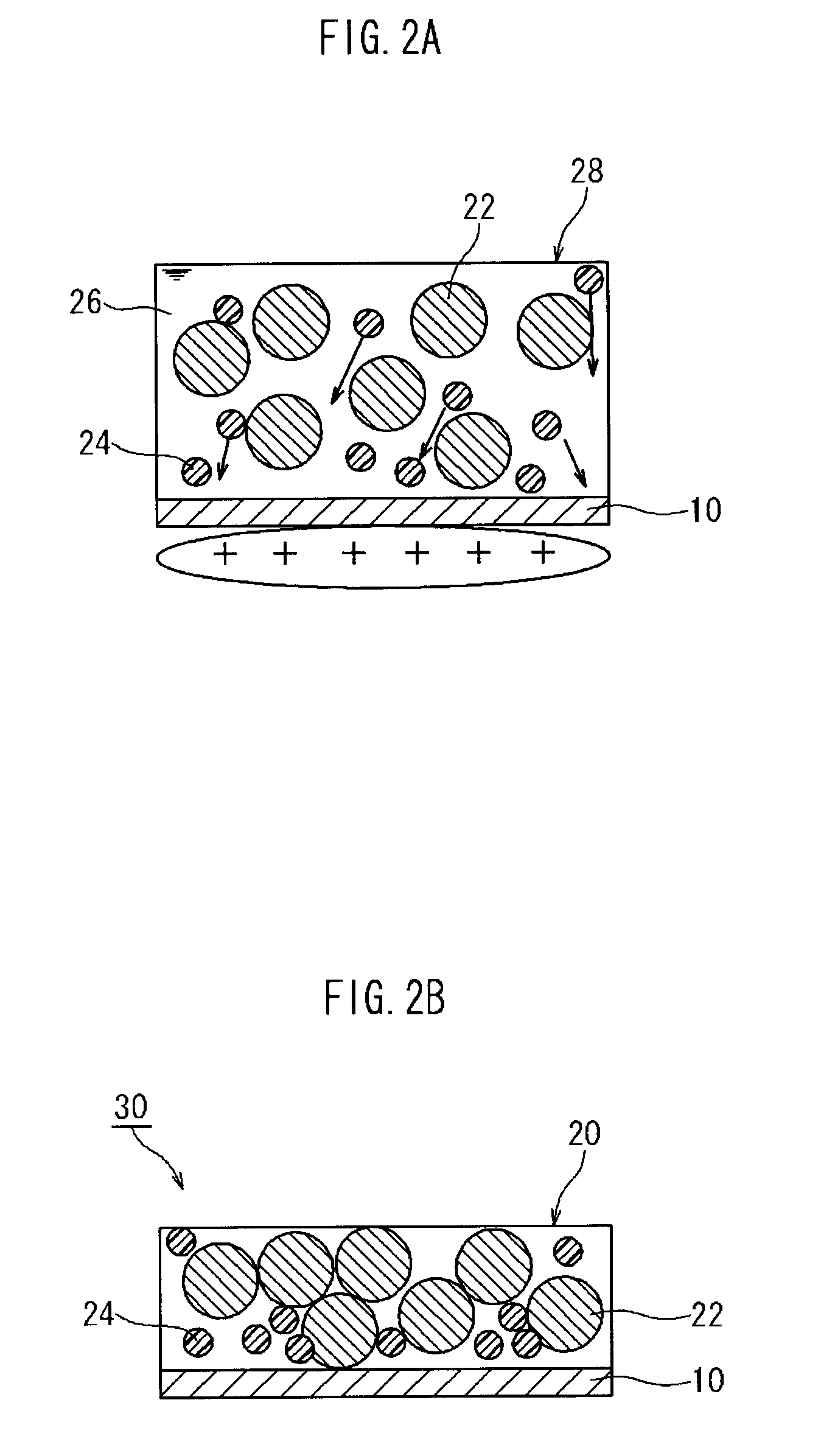Method for producing battery electrode
a battery electrode and electrode technology, applied in the direction of cell components, final product manufacturing, sustainable manufacturing/processing, etc., can solve the problems of becoming more difficult for the binder near the current collector to rise to the surface region of the paste, so as to achieve efficient application and simplify the structure of the device
- Summary
- Abstract
- Description
- Claims
- Application Information
AI Technical Summary
Benefits of technology
Problems solved by technology
Method used
Image
Examples
embodiment 1
[0035]The method for producing a battery electrode disclosed herein is a method for producing an electrode 30 having a configuration in which an active material layer 20 containing an active material 22 and a polymer material 24 is retained on a current collector 10, as shown in FIG. 1. This method comprises a step wherein a paste for forming an active material layer 28 containing the active material 22 and the polymer material 24 in a solvent 26 is applied to the current collector 10, as shown in FIG. 2A, and a step wherein the active material layer 20 is formed on the current collector 10 by drying the applied paste 28, as shown in FIG. 2B.
[0036]Here an ionic polymer 24 exhibiting cationic or anionic properties in the above paste is used as at least one kind of the above polymer material, and an electric potential having an opposite polarity to that of the ionic polymer 24 is applied to the current collector 10 after the paste has been applied thereto. The ionic polymer in this em...
embodiment 2
[0055]In the above embodiment a case is described wherein the ionic polymer functions as a binder in the active material layer, but the present invention is not limited thereto. For example, the ionic polymer can function as a thickener in the paste instead of or in addition to its function as a binder.
[0056]In other words, as shown in FIG. 4A, in this embodiment the polymer material comprises a first polymer 124 that functions as a binder in the active material layer 120 and a second polymer 125 that functions as a thickener in the paste, and an ionic polymer is used at least as the second polymer (thickener) 125. An electric potential opposite to that of the second polymer (thickener) 125 is then applied to the current collector 110 after the paste has been applied thereto.
[0057]The second polymer (thickener) 125 in this embodiment is an anionic polymer having a carboxyl group and, for example, carboxymethyl cellulose (CMC) can be used therefor. Moreover, the first polymer (binder...
example 1
[0062]In this example, a paste for forming an active material layer 28 was prepared by dispersing graphite powder as the negative electrode active material 122 and carboxylated styrene-butadiene rubber (XSBR) as the ionic polymer (binder) in water such that the mass ratio of these ingredients was 99:1. This paste for forming an active material layer 28 was applied to one side of a continuous sheet-shaped copper foil (current collector 22) such that the thickness thereof was 100 μm, and the negative electrode sheet 30 with a negative electrode active material layer 20 formed on a current collector 10 was obtained by applying a positive charge of approximately 2.4 V to the current collector using a charge roller and then drying with a hot air flow at approximately 120° C. for 20 seconds. It should also be noted that the solid content ratio of the paste for forming the active material layer was adjusted to approximately 50%. Moreover, XSBR having carboxyl groups on the order of roughly...
PUM
| Property | Measurement | Unit |
|---|---|---|
| electric potential | aaaaa | aaaaa |
| temperature | aaaaa | aaaaa |
| thickness | aaaaa | aaaaa |
Abstract
Description
Claims
Application Information
 Login to View More
Login to View More - R&D
- Intellectual Property
- Life Sciences
- Materials
- Tech Scout
- Unparalleled Data Quality
- Higher Quality Content
- 60% Fewer Hallucinations
Browse by: Latest US Patents, China's latest patents, Technical Efficacy Thesaurus, Application Domain, Technology Topic, Popular Technical Reports.
© 2025 PatSnap. All rights reserved.Legal|Privacy policy|Modern Slavery Act Transparency Statement|Sitemap|About US| Contact US: help@patsnap.com



